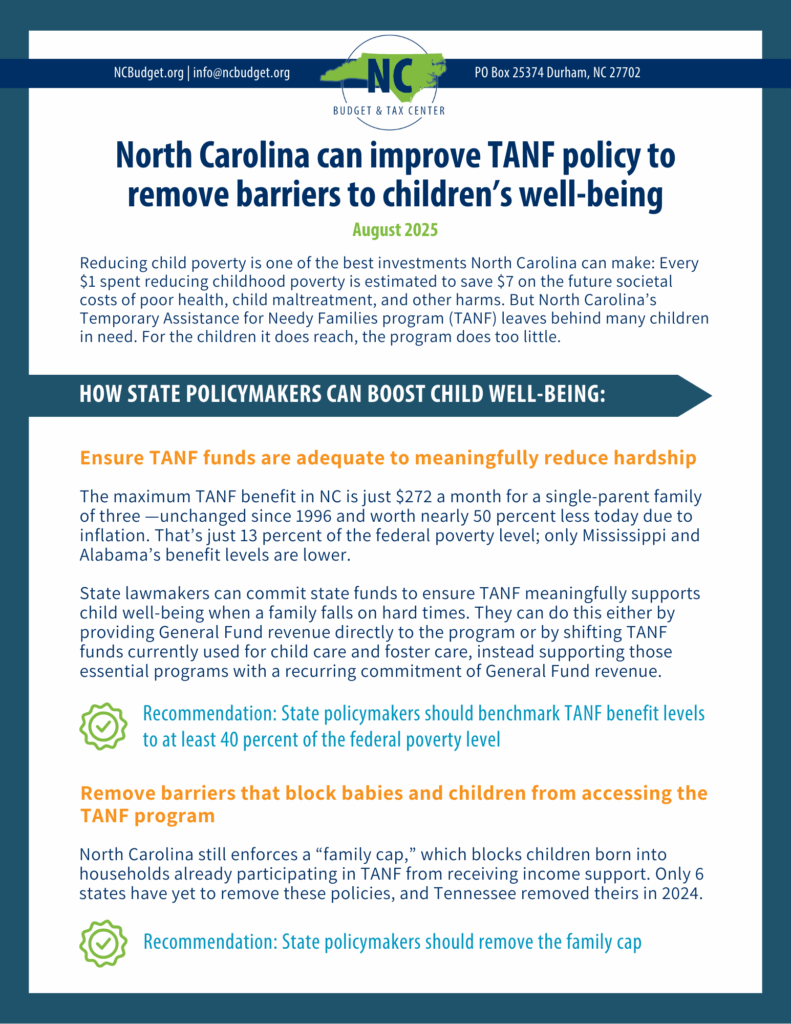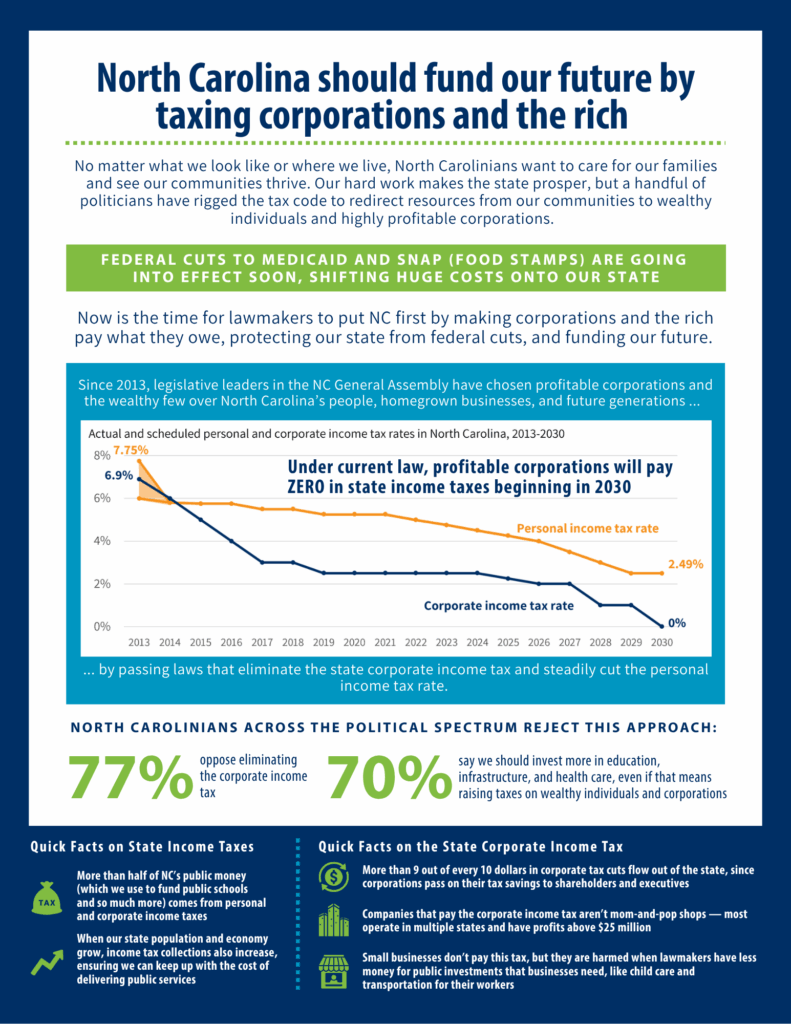North Carolina can improve TANF policy to remove barriers to children’s well-being

Note: Learn more about how North Carolina can improve TANF policy to boost employment outcomes here
Reducing child poverty is one of the best investments North Carolina can make: Every $1 spent reducing childhood poverty is estimated to save $7 on the future societal costs of poor health, child maltreatment, and other harms.1Michael McLaughlin and Mark R Rank, “Estimating the Economic Cost of Childhood Poverty in the United States,” Social Work Research 42, no. 2 (2018): 73–83, https://doi.org/10.1093/swr/svy007. But North Carolina’s Temporary Assistance for Needy Families program (TANF) leaves behind many children in need. For the children it does reach, the program does too little.
How state policymakers can boost child well-being:
Ensure TANF funds are adequate to meaningfully reduce hardship
The maximum TANF benefit in NC is just $272 a month for a single-parent family of three —unchanged since 1996 and worth nearly 50 percent less today due to inflation.2Diana Azevedo-McCaffrey and Tonanziht Aguas, Continued Increases in TANF Benefit Levels Are Critical to Helping Families Meet Their Needs and Thrive (Center on Budget and Policy Priorities, 2025), https://www.cbpp.org/research/income-security/continued-increases-in-tanf-benefit-levels-are-critical-to-helping. That’s just 13 percent of the federal poverty level; only Mississippi and Alabama’s benefit levels are lower.
State lawmakers can commit state funds to ensure TANF meaningfully supports child well-being when a family falls on hard times. They can do this either by providing General Fund revenue directly to the program or by shifting TANF funds currently used for child care and foster care, instead supporting those essential programs with a recurring commitment of General Fund revenue.
- Recommendation: State policymakers should benchmark TANF benefit levels to at least 40 percent of the federal poverty level
Remove barriers that block babies and children from accessing the TANF program
North Carolina still enforces a “family cap,” which blocks children born into households already participating in TANF from receiving income support. Only 6 states have yet to remove these policies, and Tennessee removed theirs in 2024.3Azevedo-McCaffrey and Aguas, Continued Increases in TANF Benefit Levels Are Critical to Helping Families Meet Their Needs and Thrive.
- Recommendation: State policymakers should remove the family cap
About two-thirds of states have also expanded TANF eligibility to pregnant women without minor children from the beginning of pregnancy,4 Diana Azevedo-McCaffrey and Joanna LeFebvre, Economic Security Programs Should Support Pregnant People and Their Families, Not Promote Harmful “Fetal Personhood” Agenda (Center on Budget and Policy Priorities, 2025), https://www.cbpp.org/research/income-security/economic-security-programs-should-support-pregnant-people-and-their. but NC has not yet taken this step to support healthy pregnancies and transitions to motherhood.
- Recommendation: State policymakers should make pregnant women eligible
Finally, NC’s administration of TANF is failing to ensure that families that have survived domestic violence are accessing the program waivers to which they are entitled. In both 2022 and 2023, zero TANF families received a Domestic Violence Exemption in North Carolina.5U.S. Department of Health and Human Services, Office of Family Assistance, “Table 9, Families with a Domestic Violence Exemption, Monthly Average, Fiscal Year 2023,” July 15, 2024, https://acf.gov/sites/default/files/documents/ofa/wpr2023table09.pdf.
- Recommendation: State policymakers should update family violence policies and create a new verification form for the Domestic Violence Exemption
Protect vulnerable children from harmful sanctions
North Carolina’s TANF program has strict work requirements that can be difficult to meet, despite a parent’s best efforts to comply. Right now, the state takes away the entire family’s TANF benefit if a parent fails to meet requirements. At least 10 states and Washington, DC, have eliminated these “full family sanctions,” protecting a portion of benefits for children when their parent is unable to meet program requirements.6Correspondence with the Center on Budget and Policy Priorities, May 2025.
- Recommendation: State policymakers should reform “fully family sanctions” so that 75 percent of the TANF grant is designated for children in the household and cannot be taken away, leaving 25 percent tied to adult compliance.
***
What is TANF?
The Temporary Assistance for Needy Families (TANF) program was established in the 1996 welfare reform legislation at the federal level to take the place of Aid to Families with Dependent Children, shifting the program from an entitlement to a block grant that gives states flexibility over eligibility and rules. TANF in North Carolina is called Work First. NC spends just 5 percent of its TANF funds on basic cash assistance, compared to 23 percent nationally.7Shrivastava and Manansala, To Strengthen Economic Security and Advance Equity, States Should Invest More TANF Dollars in Basic Assistance.
Footnotes
- 1Michael McLaughlin and Mark R Rank, “Estimating the Economic Cost of Childhood Poverty in the United States,” Social Work Research 42, no. 2 (2018): 73–83, https://doi.org/10.1093/swr/svy007.
- 2Diana Azevedo-McCaffrey and Tonanziht Aguas, Continued Increases in TANF Benefit Levels Are Critical to Helping Families Meet Their Needs and Thrive (Center on Budget and Policy Priorities, 2025), https://www.cbpp.org/research/income-security/continued-increases-in-tanf-benefit-levels-are-critical-to-helping.
- 3Azevedo-McCaffrey and Aguas, Continued Increases in TANF Benefit Levels Are Critical to Helping Families Meet Their Needs and Thrive.
- 4Diana Azevedo-McCaffrey and Joanna LeFebvre, Economic Security Programs Should Support Pregnant People and Their Families, Not Promote Harmful “Fetal Personhood” Agenda (Center on Budget and Policy Priorities, 2025), https://www.cbpp.org/research/income-security/economic-security-programs-should-support-pregnant-people-and-their.
- 5U.S. Department of Health and Human Services, Office of Family Assistance, “Table 9, Families with a Domestic Violence Exemption, Monthly Average, Fiscal Year 2023,” July 15, 2024, https://acf.gov/sites/default/files/documents/ofa/wpr2023table09.pdf.
- 6Correspondence with the Center on Budget and Policy Priorities, May 2025.
- 7Shrivastava and Manansala, To Strengthen Economic Security and Advance Equity, States Should Invest More TANF Dollars in Basic Assistance.



